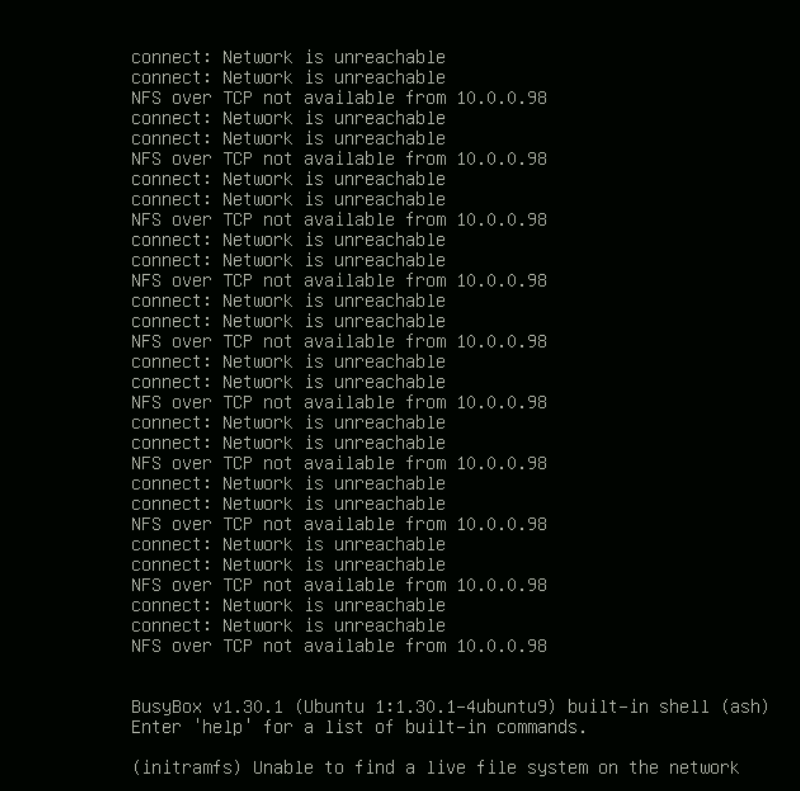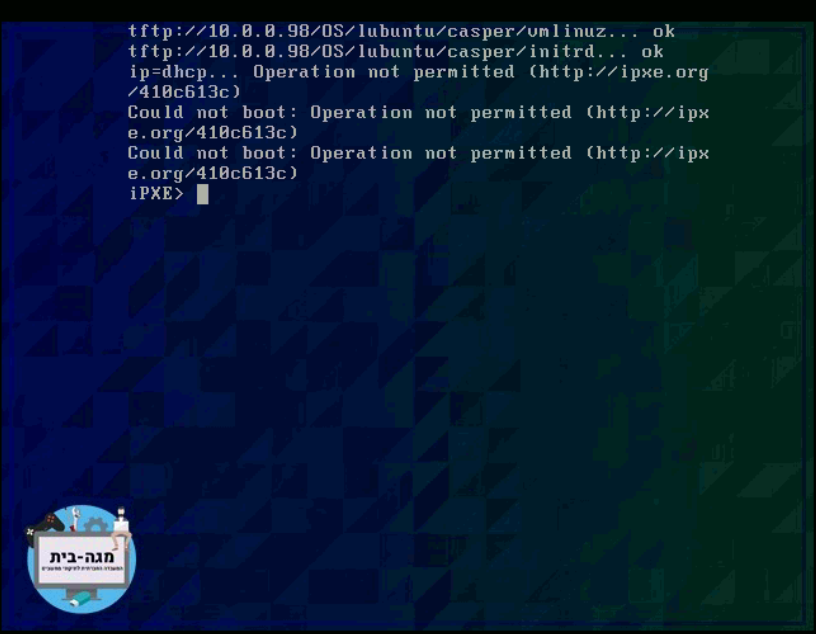I cant boot iso's like lubuntu 18.04 32 bit or kubuntu 20.04 64 bit from the fog menu
-
First of all let me point that I know about link text and tried a lot of them including windows PE and gparted but everytime i get errors like BOOT Failed
this is what i tried on lubuntu 64 bit
kernel tftp://10.0.0.98/OS/lubuntu/casper/vmlinuz
initrd tftp://10.0.0.98/OS/lubuntu/casper/initrd
imgargs vmlinuz root=/dev/nfs boot=casper netboot=nfs nfsroot=${fog-ip}:/images/os/lubuntu/ locale=en_US.UTF-8 keyboard-configuration/layoutcode=us quiet splash
boot || goto MENU
but i keep getting nfs over tcp not availablewhat I am doing wrong?
-
@aloniada Do you actually see the kernel boot? Ubuntu 20.x brought some new pains into pxe booting a live OS. I’m suspecting the
nfsroot=${fog-ip}:/images/os/lubuntu/is causing some issues.If you look at a debian image args
imgargs vmlinuz initrd=initrd boot=live components fetch=http://${fog-ip}/os/debian/10.7L/filesystem.squashfsThey are actually fetching the filesystem using http.
I also noticed that you mix 32 bit and 64 bit. Are you implying that both will not boot via pxe?
-
@george1421 said in I cant boot iso's like lubuntu 18.04 32 bit or kubuntu 20.04 64 bit from the fog menu:
@aloniada Do you actually see the kernel boot? Ubuntu 20.x brought some new pains into pxe booting a live OS. I’m suspecting the nfsroot=${fog-ip}:/images/os/lubuntu/ is causing some issues.
If you look at a debian image args
imgargs vmlinuz initrd=initrd boot=live components fetch=http://${fog-ip}/os/debian/10.7L/filesystem.squashfs
They are actually fetching the filesystem using http.
I also noticed that you mix 32 bit and 64 bit. Are you implying that both will not boot via pxe?yes i can see the kernal booting and in the lubuntu 64Bit 20.04 i can see the logo for about a second or two until I get kicked out to the busybox screen and nothing else from here

this is a VM from the server itself so no way it’s network issueI tried multiple distro’s ranging from lubuntu, kubuntu and windows PE (I want to setup both 64 and 32 bit to have all of ubuntu distro i mentioned (and sergei strelec iso around my workspace without having to get a thumb stick for each computer i work on.
(I volunteer at a free computer repair shop so I need all the extra help I can get so I can fix it quickly and move to the next one)
-
@aloniada The error messages
Network is unreachabletell us that the PXE booting client is not able to talk to the IP 10.0.0.98. The message usually comes from the gateway not being properly set. I imagine your client will receive an IP in a different subnet (e.g. 192.168.x.y) but no gateway/router IP to talk to the FOG server on a different subnet. -
@sebastian-roth
umm, I don’t follow.
10.0.0.98 is a manual ip address that is the ip of the server. every other ip is within 10.0.0.X
IPV4:10.0.0.X
Subnet mask:255.255.255.0
Gateway:10.0.0.138
(it’s the default gateway and subnet mask in israel)here’s my windows machine ip via ipconfig showing the same configuration

https://www.youtube.com/watch?v=6-L1rxet86Q
(here’s a video showing I get response from my server and trying to live boot lubuntu 64X) -
@aloniada Where did you get vmlinuz and initrd from? Was it off the lubuntu iso image? If so, if lubuntu is similar to ubuntu and debian, you need to use the netboot kernels. This is typically a separate download you need to get.
At the time vmlinuz starts, the lubuntu kernel is in charge. The only thing the fog server is just sharing its disk via nfs.
-
@sebastian-roth said in I cant boot iso's like lubuntu 18.04 32 bit or kubuntu 20.04 64 bit from the fog menu:
Network is unreachable
Maybe I got that one wrong and your live booted system does not grab an IP at all. I suggest you add
ip=dhcpto theimgargsline and see if that makes a difference.Seems like this behaviour changed some time in Ubuntu 19.xx: https://bugs.launchpad.net/ubuntu/+source/casper/+bug/1848018 (see comment #2)
If that doesn’t help you might grab the netbook kernel and initrd mentioned by @george1421 - here is one for Ubuntu Bionic: http://archive.ubuntu.com/ubuntu/dists/bionic-updates/main/installer-amd64/current/images/netboot/ubuntu-installer/amd64/ (choose a different one that matches your L/Kubuntu version…)
-
om so first of all I didn’t looked that the lubuntu was 64bit (which I don’t use actively so it’s in the backburner for now) and the 32 BIT one works with the original code so my bad and thank you so much for your help.
I cant find focal netboot so I think for now i take my win for now.
P.S is there a way to boot windows 7/10 installation from FOG?
-
@aloniada From the picture you posted it looks like the parameter
ip=dhcpis not properly in theimgargsline. At least iPXE thinks you ask it to run this as an iPXE command.P.S is there a way to boot windows 7/10 installation from FOG?
I don’t know anything about this. You already found the most up to date topic on live booting systems/installers: https://forums.fogproject.org/topic/10944/using-fog-to-pxe-boot-into-your-favorite-installer-images
-
@sebastian-roth
Oh ok so where do i need to putip=dhcpthis is the current iPXE code
this is what i tried on lubuntu 64 bitkernel tftp://10.0.0.98/OS/lubuntuX86/casper/vmlinuz initrd tftp://10.0.0.98/OS/lubuntuX86/casper/initrd imgargs vmlinuz root=/dev/nfs boot=casper ip=dhcp netboot=nfs nfsroot=10.0.0.98:/images/os/lubuntu/ locale=en_US.UTF-8 keyboard-configuration/layoutcode=us quiet splash boot || goto MENUI forgot to comment on the picture, and I didn’t want to double post lol

I tried couple of location but it didn’t seems to work anywhere -
@aloniada Interesting. I have not tried it myself as I don’t use live OS booting. Just trying to help with what I find on the web. I would imagine the parameter can go pretty much anywhere in the
imgargsline.When you moved it to different positions, did you always get the exact same error message. I can’t think of why iPXE would grab that out of the imgargs line…
-
@aloniada Playing with this today I figured out what changed in (U/Ku/Lu)buntu and Mint from 20.04 (or maybe earlier) that causes the mentioned error
Unable to find a live file system on the networkeven if you add theip=parameter (which you definitely have to!)…You need to copy the hidden folder
.diskfrom the ISO as well which is missed when using the copy command. See more details here: https://forums.fogproject.org/topic/14590/20-04-autoinstallBut be aware that in your case you need to get the
ip=parameter right first so theNFS over TCP not available ...error goes away!this is a VM from the server itself so no way it’s network issue
I also ran into an issue where
ip=dhcpdid not work in a VM setup. I actually had to set a static IP - which really is a shame!!! So instead ofip=dhcpthis worked for me:... ip=192.168.3.123::192.168.3.1:255.255.255.0:hostname:enp0s3:none:192.168.3.1 ...
